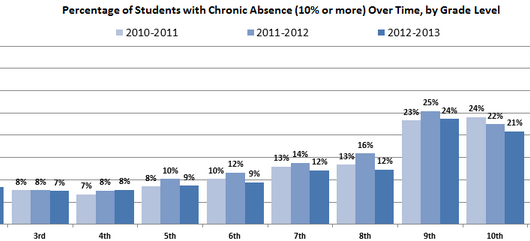Use Chronic Absence Data to Determine Need for Additional Supports
While a strong schoolwide culture of attendance is an essential basic ingredient of academic success that should exist in all schools, it may not always be sufficient. Some students, especially those who are chronically absent, may need a higher level of intervention. The best predictor of chronic absence in the current year is poor attendance during the prior year and/or the first month of school.
The good news is chronic absence can be turned around if data is used to identify and connect them — as early as possible — to positive, engaging supports that motivate them to attend school and address challenging barriers. Principals can use their data to determine the extent to which additional supports are needed in their school.
Secure Your School’s Chronic Absence Data
Chronic absence data for your school should be produced and made available to you by your district. If it has not yet been provided, ask your district for data showing the extent to which students are missing 10 percent of the school year for any reason — excused or unexcused absences and suspensions. The data should illustrate whether chronic absence is a problem for your entire school, as well as for specific grades and student populations. If possible, especially if chronic absence is very high in a particular grade, review levels by classroom. Make sure your district is calculating chronic absence, versus just truancy or average daily attendance.
If your district does not currently have the capacity to calculate chronic absence, encourage your central office to use the free attendance tracking tools available from Attendance Works. These tools track attendance trends related to satisfactory attendance (missing less than 5 percent of school), at-risk attendance (missing 6-10 percent of school), moderate chronic absence (missing 10-19 percent) and severe chronic absence (missing 20 percent or more).
Review Your School’s Attendance Data
Once the data report is available to you, spend time reviewing the results possibly in concert with other school staff, or possibly even community partners who can help interpret what it means.
Use Data to Provide Additional Supports to Chronically Absent Students
Absenteeism records from past years and from the first month of school can identify students at risk of chronic absence and can be used to connect these students to a higher tier of support. This extra support typically involves helping students and their families build strong, positive and caring relationships with school staff and other students, connect to engaging learning activities and overcome any barriers to attendance.
When implemented early in the school year, this approach can help students — supported by their families — start the year with good attendance, rather than find themselves struggling because they have fallen behind as a result of too many absences.
If large numbers of students are affected by chronic absence, systemic barriers may be at play. Identifying these can indicate the appropriate solutions, whether that involves establishing uniform closets, improving access to health care, launching “walking school buses” to help children walk to school safely, tutoring, mentoring, developing morning or afterschool care or other approaches.
Research demonstrates that students who are eligible for free and reduced meals are three to four times more likely to be chronically absent. The challenges associated with limited resources directly contribute to whether students attend regularly. Keeping in mind the barriers created by poverty can be important in addressing widespread chronic absence and generally requires involving agency, non-profit and community partners.
Set Goals and Monitor Progress
A common saying is what gets measured is what gets done. This is particularly true with chronic absence and attendance. It isn’t enough to say that attendance is a priority. An essential ingredient for change is building in shared accountability for reducing chronic absence into how you assess staff members. Principals can create accountability by visibly recognizing contributions to improving attendance, as well as by building in metrics into schoolwide and individual performance measures.
